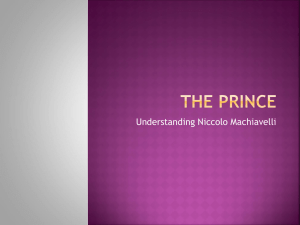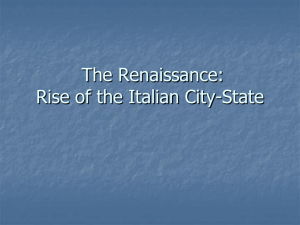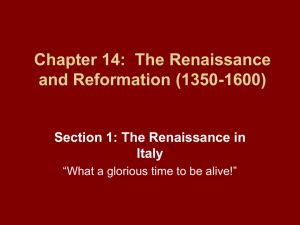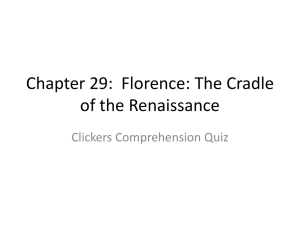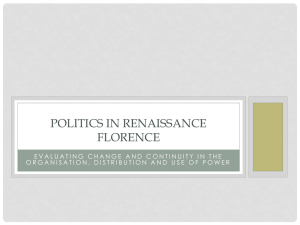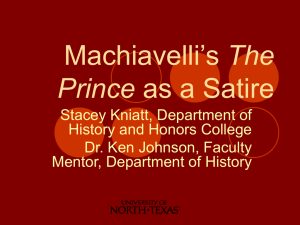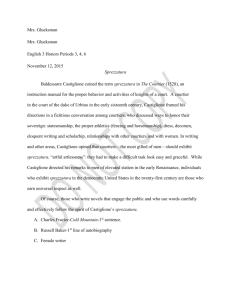File
advertisement
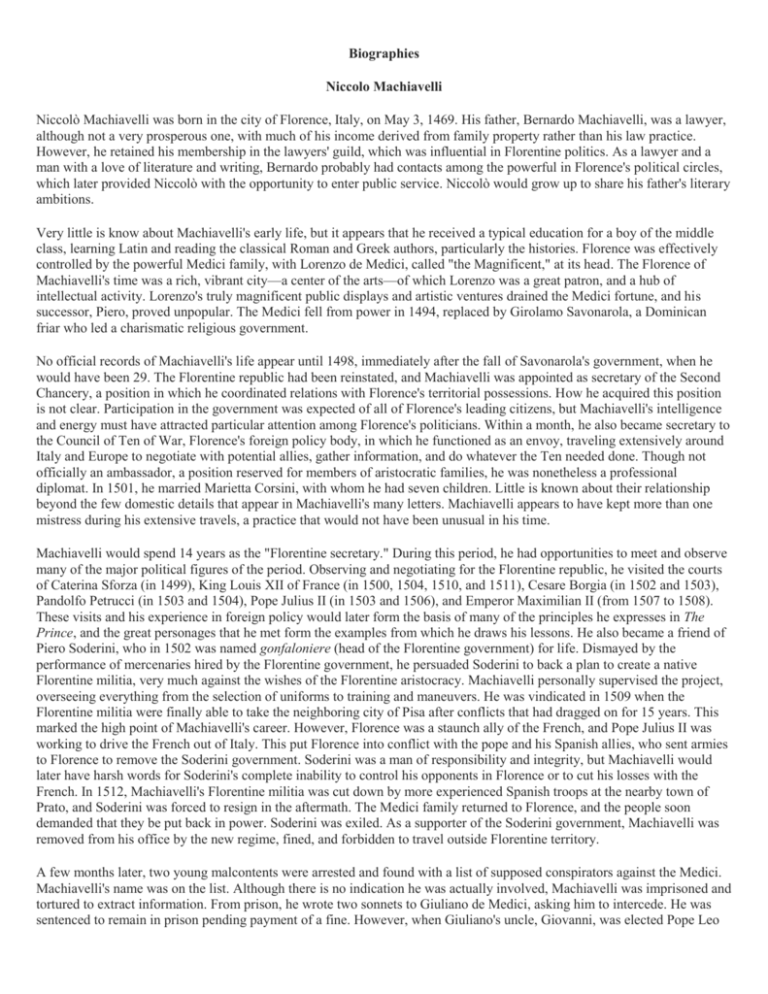
Biographies
Niccolo Machiavelli
Niccolò Machiavelli was born in the city of Florence, Italy, on May 3, 1469. His father, Bernardo Machiavelli, was a lawyer,
although not a very prosperous one, with much of his income derived from family property rather than his law practice.
However, he retained his membership in the lawyers' guild, which was influential in Florentine politics. As a lawyer and a
man with a love of literature and writing, Bernardo probably had contacts among the powerful in Florence's political circles,
which later provided Niccolò with the opportunity to enter public service. Niccolò would grow up to share his father's literary
ambitions.
Very little is know about Machiavelli's early life, but it appears that he received a typical education for a boy of the middle
class, learning Latin and reading the classical Roman and Greek authors, particularly the histories. Florence was effectively
controlled by the powerful Medici family, with Lorenzo de Medici, called "the Magnificent," at its head. The Florence of
Machiavelli's time was a rich, vibrant city—a center of the arts—of which Lorenzo was a great patron, and a hub of
intellectual activity. Lorenzo's truly magnificent public displays and artistic ventures drained the Medici fortune, and his
successor, Piero, proved unpopular. The Medici fell from power in 1494, replaced by Girolamo Savonarola, a Dominican
friar who led a charismatic religious government.
No official records of Machiavelli's life appear until 1498, immediately after the fall of Savonarola's government, when he
would have been 29. The Florentine republic had been reinstated, and Machiavelli was appointed as secretary of the Second
Chancery, a position in which he coordinated relations with Florence's territorial possessions. How he acquired this position
is not clear. Participation in the government was expected of all of Florence's leading citizens, but Machiavelli's intelligence
and energy must have attracted particular attention among Florence's politicians. Within a month, he also became secretary to
the Council of Ten of War, Florence's foreign policy body, in which he functioned as an envoy, traveling extensively around
Italy and Europe to negotiate with potential allies, gather information, and do whatever the Ten needed done. Though not
officially an ambassador, a position reserved for members of aristocratic families, he was nonetheless a professional
diplomat. In 1501, he married Marietta Corsini, with whom he had seven children. Little is known about their relationship
beyond the few domestic details that appear in Machiavelli's many letters. Machiavelli appears to have kept more than one
mistress during his extensive travels, a practice that would not have been unusual in his time.
Machiavelli would spend 14 years as the "Florentine secretary." During this period, he had opportunities to meet and observe
many of the major political figures of the period. Observing and negotiating for the Florentine republic, he visited the courts
of Caterina Sforza (in 1499), King Louis XII of France (in 1500, 1504, 1510, and 1511), Cesare Borgia (in 1502 and 1503),
Pandolfo Petrucci (in 1503 and 1504), Pope Julius II (in 1503 and 1506), and Emperor Maximilian II (from 1507 to 1508).
These visits and his experience in foreign policy would later form the basis of many of the principles he expresses in The
Prince, and the great personages that he met form the examples from which he draws his lessons. He also became a friend of
Piero Soderini, who in 1502 was named gonfaloniere (head of the Florentine government) for life. Dismayed by the
performance of mercenaries hired by the Florentine government, he persuaded Soderini to back a plan to create a native
Florentine militia, very much against the wishes of the Florentine aristocracy. Machiavelli personally supervised the project,
overseeing everything from the selection of uniforms to training and maneuvers. He was vindicated in 1509 when the
Florentine militia were finally able to take the neighboring city of Pisa after conflicts that had dragged on for 15 years. This
marked the high point of Machiavelli's career. However, Florence was a staunch ally of the French, and Pope Julius II was
working to drive the French out of Italy. This put Florence into conflict with the pope and his Spanish allies, who sent armies
to Florence to remove the Soderini government. Soderini was a man of responsibility and integrity, but Machiavelli would
later have harsh words for Soderini's complete inability to control his opponents in Florence or to cut his losses with the
French. In 1512, Machiavelli's Florentine militia was cut down by more experienced Spanish troops at the nearby town of
Prato, and Soderini was forced to resign in the aftermath. The Medici family returned to Florence, and the people soon
demanded that they be put back in power. Soderini was exiled. As a supporter of the Soderini government, Machiavelli was
removed from his office by the new regime, fined, and forbidden to travel outside Florentine territory.
A few months later, two young malcontents were arrested and found with a list of supposed conspirators against the Medici.
Machiavelli's name was on the list. Although there is no indication he was actually involved, Machiavelli was imprisoned and
tortured to extract information. From prison, he wrote two sonnets to Giuliano de Medici, asking him to intercede. He was
sentenced to remain in prison pending payment of a fine. However, when Giuliano's uncle, Giovanni, was elected Pope Leo
X in March 1513, a general amnesty was declared in celebration, and Machiavelli was released. He retired to the relative
safety of his home in the country outside Florence to rest and consider his future. During this time, he wrote many letters to
his friend and fellow Florentine diplomat Francesco Vettori, who had been appointed ambassador to Rome, looking for news
of the outside world and hoping Vettori could recommend him to the Medici family. In this self-imposed exile, he wrote The
Prince (Il Principe), which distilled his observations about human behavior, leadership, and foreign policy. He dedicated the
work to the Medici family in an effort to demonstrate his support, but without success. It was clear by 1515 that the Medici
would have nothing to do with him and that his diplomatic career was over.
Over the next ten years, deprived of the political activities that were his life's work, Machiavelli turned his attention to
writing. During this period, he produced a treatise on the art of war, one that draws on his experience as organizer of the
militia, and a commentary on the writings of the classical Roman historian Livy. Examining Livy's account of the Roman
republic, Machiavelli discussed at length the concept of republican government. In contrast with The Prince, which supports
monarchy or even tyranny, the Discourses on Livy are often cited as evidence of Machiavelli's republican sympathies. He
also wrote many poems and three comedic plays.
His writing attracted the attention of Cardinal Giulio de Medici, who had for several years been in control of Florence and
who commissioned him to write a history of Florence. He worked on his Florentine History from 1520 to 1524. Giulio was
elected Pope Clement VII in 1523, and Machiavelli presented the finished History to him in 1525. Reconciliation with the
Medici brought about Machiavelli's brief return to public service. He was put in charge of military arrangements for Clement
in Florence. However, Clement was defeated by Roman enemies that resulted in his humiliation and the sacking of the papal
palace and church of St. Peter. Soon after, Rome fell, and the great Catholic city was terrorized and looted by mostly German
Protestant armies. This debacle, and the threat posed to Florence by the advancing forces of Clement's enemies, led the
Florentines to depose the Medici family in 1527. Machiavelli, a staunch supporter and lifelong defender of the Florentine
republic, was on the losing side once again, now suspected by the republicans for having been in league with the Medici.
However, he did not have long to dwell on the irony of his position. He died after an illness in June 1527.
Pico de Mirandola
Pico de Mirandola, Italian philosopher and writer, the youngest son of Giovanni Francesco Pico, prince of Mirandola, a small
territory about 30 Italian miles west of Ferrara, afterwards absorbed in the duchy of Modena, was born on the 24th of
February 1463. The family was illustrious and wealthy, and claimed decent from Constantine. In his fourteenth year Pico
went to Bologna, where he studied for two years, and was much occupied with the Decretals. The traditional studies of the
place, however, disgusted him; and he spent seven years wandering through all the schools of Italy and France and collecting
a precious library. Besides Greek and Latin he knew Hebrew, Chaldee and Arabic; and his Hebrew teachers introduced him
to the Kabbalah, which had great fascinations for one who loved all mystic and theosophic speculation.
His learned wanderings ended (1486) at Rome, where he set forth for public disputation a list of nine hundred questions and
conclusions in all branches of philosophy and theology. He remained a year in Rome, but the disputation he proposed was
never held. The pope prohibited the little book in which they were contained, and Pico had to defend the impugned theses
(De omni re scibili) in an elaborate Apologia. His personal orthodoxy was, however, subsequently vindicated by a brief of
Alexander VI, dated 18th June 1493. The suspected theses included such points as the following: that Christ descended ad
inferos not in His real presence but quoad effectum; that no image or cross should receive latreia even in the sense allowed by
Thomas; that it is more reasonable to regard Origen as saved than as damned; that it is not in a man's free will to believe or
disbelieve an article of faith as he pleases. But perhaps the most startling thesis was that no science gives surer conviction of
the divinity of Christ than "magia" (i.e. the knowledge of the secrets of the heavenly bodies) and Kabbalah. Pico was the first
to seek in the Kabbalah a proof of the Christian mysteries and it was by him that Reuchlin was led into the same delusive
path.
Pico had been up to this time a gay Italian nobleman; he was tall, handsome, fair complexioned, with keen grey eyes and
yellow hair, and a great favorite with women. But his troubles led him to more serious thoughts; and he published, in his 28th
year, the Heptaplus, a mystical exposition of the creation. Next he planned a great seven-fold work against the enemies of the
Church, of which only the section directed against astrology was completed. After leaving Rome he again lived a wandering
life, often visiting Florence, to which he was drawn by his friends Politian and Marsilius Ficinus, and where also he came
under the influence of Savonarola. It was at Florence that he died on the 17th of November 1494. Three years before his
death he parted with his share of the ancestral principality, and designed, when certain literary plans were completed, to give
away all he had and wander barefoot through the world preaching Christ. But these plans were cut short by a fever which
carried him off just at the time when Charles VIII was at Florence.
Pico's works cannot now be read with much interest, but the man himself is still interesting, partly from his influence on
Reuchlin and partly from the spectacle of a truly devout mind in the brilliant circle of half-pagan scholars of the Florentine
renaissance.
His works were published at Bologna in 1496 by his nephew, Giov. Fran. Pico, with a biography, which was translated by Sir
Thomas More as Life of John Picus, Earl of Mirandola, in 1510.
Giorgio Vasari
(Arezzo, Tuscany July 3, 1511 - Florence, June 27, 1574) was an Italian painter and architect, mainly known for his famous
biographies of Italian artists.
At a very early age he became a pupil of Guglielmo da Marsiglia, a very skillful painter of stained glass, to whom he was
recommended by his own kinsman, the painter Luca Signorelli. At the age of sixteen Cardinal Silvio Passerini who sent him to
study in Florence, in the circle of Andrea del Sarto and his pupils Rosso and Jacopo Pontormo. His humanist education was not
ignored, and he met and knew Michelangelo, whose painting style influenced Vasari's.
In 1529 he visited Rome and studied the works of Raphael and others of the Roman High Renaissance of the previous
generation. Vasari's own Mannerist paintings were more admired in his lifetime than afterwards. He was consistently employed
by patrons in the Medici family in Florence and Rome, and he worked in Naples, Arezzo and other places. Many of his pictures
still exist, the most important being the wall and ceiling paintings in the great hall of the Palazzo Vecchio in Florence, and his
broad, uncompleted frescoes inside the dome of the Florentine Duomo.
As an architect he was perhaps more successful: the loggia of the Palazzo degli Uffizi by the Arno, the urbanistic planning of its
long narrow courtyard that functions as a public piazza, and the long passage connecting it with the Pitti Palace, through Ponte
Vecchio, are his chief work. He worked with Giacomo Vignola and Bartolomeo Ammanati at the Villa di Papa Giulio ("[[Villia
Giulia") in Rome. Unhappily he did much to injure the fine medieval churches of Santa Maria Novella and Santa Croce, from
both of which he removed the original rood-screen and loft, and remodeled the retro-choir in the Mannerist taste of his time.
Vasari enjoyed a very high repute during his lifetime and amassed a considerable fortune. He built himself in 1547 a fine house
in Arezzo (now a museum honoring him), and spent much labor in decorating its walls and vaults with paintings. He was elected
one of the municipal council or priori of his native town, and finally rose to the supreme office of gonfaloniere.
In 1563 he founded the Accademia del Disegno at Florence, with the Grand Duke and Michelangelo as capi of the institution and
thirty-six artists chosen for members. He died at Florence on June 27, 1571.
As the first Italian art historian, he initiated the genre of an encyclopedia of artistic biographies that continues today. Vasari
coined the term "Renaissance (rinascita) in print, though an awareness of the ongoing "rebirth" in the arts had been in the air
from the time of Alberti. Vasari's great work was first published in 1550, and dedicated to Grand Duke Cosimo I de' Medici; it
included a valuable treatise on the technical methods employed in the arts. It was partly rewritten and enlarged in 1568 and
provided with woodcut portraits of artists (some conjectural), entitled Delle Vite de' più eccellenti pittori, scultori, ed architettori.
In Lives of Painters is biographies are interspersed with amusing stories. With a few exceptions Vasari's esthetic judgment is
acute and unbiased. Vasari did not rifle archives for exact dates, as modern art historians do, and naturally his biographies are
more dependable for the painters of his own generation and the preceding one. The work remains a classic. Vasari gives a sketch
of his own biography at the end, and adds further details about himself and his family in his lives of Lazzaro Vasari and
Francesco Salviati. The Lives have been translated into French, German and English.
Pietro Aretino
(Born April 20, 1492, Arezzo, Republic of Florence [Italy]—died October 21, 1556, Venice), Italian poet, prose writer, and
dramatist celebrated throughout Europe in his time for his bold and insolent literary attacks on the powerful. His fiery letters and
dialogues are of great biographical and topical interest.
Although Aretino was the son of an Arezzo shoemaker, he later pretended to be the natural son of a nobleman and derived his
adopted name (“the Aretine”) from that of his native city (his real name is unknown). While still very young, he went to Perugia
and painted for a time and then moved on to Rome in 1517, where he wrote a series of viciously satirical lampoons supporting
the candidacy of Giulio de’ Medici for the papacy (Giulio became Pope Clement VII in 1523). Despite the support of the pope
and another patron, Aretino was finally forced to leave Rome because of his general notoriety and his 1524 collection of Sonetti
lussuriosi (“Lewd Sonnets”). From Rome he went to Venice (1527), where he became the object of great adulation and lived in a
grand and dissolute style for the rest of his life. One of Aretino’s closest friends in Venice was the painter Titian, for whom he
sold many paintings to Francis I, king of France; a great gold chain that Aretino wears in Titian’s portrait (c. 1545; Pitti Palace,
Florence) was a gift from the king.
Among Aretino’s many works, the most characteristic are his satirical attacks, often amounting to blackmail, on the powerful.
He grew wealthy on gifts from kings and nobles who feared his satire and coveted the fame accruing from his adulation. His six
volumes of letters (published 1537–57) show his power and cynicism and give ample justification for the name he gave himself,
flagello dei principe (“scourge of princes”). Aretino was particularly vicious in his attacks on Romans because they had forced
him to flee to Venice. In his Ragionamenti (1534–36; modern edition, 1914; “Discussions”), Roman prostitutes reveal to each
other the moral failings of many important men of their city, and in I dialoghi and other dialogues he continues the examination
of carnality and corruption among Romans.
Only Aretino’s dramas are relatively free of such venomous assaults. His five comedies are acutely perceived pictures of lowerclass life, free from the conventions that burdened other contemporary dramas. Of the five comedies, written between 1525 and
1544 (modern collection, Commedie, 1914), the best known is Cortigiana (published 1534, first performed 1537, “The
Courtesan”), a lively and amusing panorama of the life of the lower classes in papal Rome. Aretino also wrote a tragedy, Orazia
(published 1546; “The Horatii”), which has been judged by some the best Italian tragedy written in the 16th century.
Francesco Petrarch
Francesco Petrarca, also known simply as Petrarch, was born on July 20, 1304, in Arrezo, Italy. He followed his father, who had
been exiled for political reasons, first to Pisa, then to Avignon. There he received instruction in grammar, rhetoric, and dialectic.
He finally began studying law in Bologna for a time, then in Montepellier, but he never finished his course of studies. During
his time in Montepellier, he had the chance to experience the art of the troubadour, which awakened his interest in Roman poetry
and literature and decidedly influenced his later creative work. He returned to Avignon in 1326 and met the married Madonna
Laura for the first time. She was his source of inspiration until her death. He dedicated his famous "Canzoniere" to her, a poetry
collection dealing with his unrequited love for her. With this form of love poetry, Petrarch had such a great influence on
European poetry of the Middle Ages that a new style was named for him, Petrarchism, which lived late into modern times and
influenced, among other traditions, the German Minnesang. After journeys through France, Belgium, Germany, and Italy,
during which he met his later students Boccaccio and Cola di Rienzo, he returned to Vaucluse in 1337. For the next few years,
he dedicated himself exclusively to his work. Within the context of Italian literature, Petrarch's work represents the transition
from a medieval tradition, beholden to Dante, to a modern literature. This is mainly because of his introduction of Italian as the
language of his poetry. In his "Epistulae," Petrarch's humanistic attitude is shown in full. Also, the first depiction of nature in
European literature appears here: a description of climbing Mount Ventoux, from whose pinnacle Petrarch described the
surrounding landscape. Another work in Italian is the allegorical-didactic poem "Trionfi," a religious work in which his
humanistic education is fully revealed. In 1341, Rome reintroduced the old Roman tradition of the crowning of the "poeta
laurentis" (poet laureate), in order to appropriately honor Petrarch. In 1353, he went to Milan in order to put his diplomatic
abilities to use in the service of the viscount. He stayed in Venice in 1362. Petrarch returned to Argua in 1368, where he died
on July 18, 1374.
Baldassare Castiglione
Castiglione was born into an illustrious family at Casatico, near Mantua (Lombardy), where his family had constructed an
impressive palazzo. The signoria (lordship) of Casatico (today part of the commune of Marcaria) had been assigned to an
ancestor, Baldassare da Castiglione, a friend of Ludovico III Gonzaga, Marquis of Mantua, in 1445. The later Baldassare was
related to Ludovico Gonzaga through his mother, Luigia Gonzaga.
In 1494 at the age of sixteen Castiglione began his humanist studies in Milan, studies which would eventually inform his future
writings. However, in 1499 after the death of his father, Castiglione left his studies and Milan to succeed his father as the head of
their noble family. Soon his duties included officially representing the Gonzaga court; for instance, he accompanied his marquis
for the Royal entry at Milan of Louis XII. He traveled quite often for the Gonzagas; during one of his missions to Rome he met
Guidobaldo da Montefeltro, Duke of Urbino; and in 1504, a reluctant Francesco Gonzaga allowed him to leave and take up
residence in that court.
Urbino was at that time the most refined and elegant of the Italian courts, a cultural center ably directed and managed by the
Duchess Elisabetta Gonzaga and her sister-in-law Emilia Pia, whose portraits, along with those of many of their guests, were
painted by Raphael, a native of Urbino. Regular guests included: Pietro Bembo; Ludovico da Canossa; Giuliano de' Medici;
Cardinal Bibbiena; the brothers Ottaviano and Federigo Fregoso from the Republic of Genoa.; Francesco Maria della Rovere
(nephew and heir of Duke and Duchess of Urbino); and Cesare Gonzaga, a cousin of both Castiglione and the Duke. The hosts
and guests organized intellectual contests, pageants, dances, concerts, recitations, plays, and other cultural activities, producing
brilliant literary works. Elisabetta's virtue and abilities inspired Castiglione to compose a series of Platonic love songs and
sonnets in her honor. She deeply loved her husband though his invalid state meant they could never have children.
In 1506 Castiglione wrote (and acted in) a pastoral play, his eclogue Tirsi, in which he depicted the court of Urbino allegorically
through the figures of three shepherds. The work contains echoes of both ancient and contemporary poetry, recalling Poliziano
and Sannazzaro as well as Virgil.
Castiglione wrote about his works and of those of other guests in letters to other princes, maintaining an activity very near to
diplomacy, though in a literary form, as in his correspondence with his friend and kinsman, Ludovico da Canossa (later Bishop
of Bayeux).
Francesco Maria della Rovere succeeded as Duke of Urbino at Guidobaldo's death, and Castiglione remained at his court. He
and the new Duke of Urbino took part in Pope Julius II's expedition against Venice, an episode in the Italian Wars. For this the
Duke conferred on Castiglione the title of Count of Novilara, a fortified hill town near Pesaro. When Pope Leo X was elected in
1512, Castiglione was sent to Rome as ambassador from Urbino. There he was friendly with many artists and writers; including
Raphael, whom he already knew from Urbino, and who frequently sought his advice. In tribute to their friendship, Raphael
painted his famous portrait of Castiglione, now at the Louvre.
In 1516 Castiglione was back in Mantua, where he married a very young Ippolita Torelli, descendant of another noble Mantuan
family. That Castiglione's love for Ippolita was of a very different nature from his former platonic attachment to Elisabetta
Gonzaga is evidenced by the two deeply passionate letters he wrote to her that have survived. Sadly, Ippolita died a mere four
years after their marriage, while Castiglione was away in Rome as ambassador for the Duke of Mantua. In 1521 Pope
Leo X conceded to him the tonsura (first sacerdotal ceremony) and thereupon began Castiglione's second, ecclesiastical career.
In 1524 Pope Clement VII sent Castiglione to Spain as Apostolic nuncio (ambassador of the Holy See) in Madrid, and in this
role he followed court of Emperor Charles V to Toledo, Seville and Granada. At the time of the Sack of Rome (1527) Pope
Clement VII suspected Castiglione of having harbored a "special friendship" for the Spanish emperor: Castiglione, the Pope
believed, should have informed the Holy See of Charles V's intentions, for it was his duty to investigate what Spain was
planning against the Eternal City. On the other hand, Alonso de Valdés, twin brother of the humanist Juan de Valdés and
secretary of the emperor, publicly declared the sack to have been a divine punishment for the sinfulness of the clergy.
Castiglione answered both the Pope and Valdés in two famous letters from Burgos. He took Valdés to task, severely and at
length, in his response to the latter's comments about the Sack of Rome. While in his letter to the Pope (dated December 10,
1527), he had the audacity to criticize Vatican policies, asserting that its own inconsistencies and vacillations had undermined its
stated aim of pursuing a fair agreement with the emperor and had provoked Charles V to attack.
Against all expectations, Castiglione received the Pope's apologies and the emperor honored him with the offer of the position of
Bishop of Avila. Historians today believe that Castiglione had carried out his ambassadorial duties to Spain in an honorable
manner and bore no responsibility for the sack of Rome. He died of the plague in Toledo in 1529.
Isabelle d’Este
Daughter of Ercole I d'Este and Eleonora of Aragon she enjoyed the benefits of a classical education in one of Italy's most
distinguished courts, despite the disruptions occasioned by the War of Venice-Ferrara (1482-84). Among her teachers was
Battista Guarini, Guarino da Verona's son and his successor in the chair of rhetoric at Ferrara. Her later concerns for classical
learning and astrology also suggest the influence of the ducal librarian, Pellegrino Prisciano, and other humanists in the ducal
circle.
At the time of her marriage at the age of 16 to Francesco Gonzaga {15 February 1490), Isabella was already recognized as an
exceptionally astute and cultivated woman, clearly the equal of her husband both intellectually and socially. Francesco's
predilections for military life, combined with Isabella's manifest skills and interests in diplomacy, meant that they spent little
time together.
She brought energy, intelligence and judgment to her patronage of literature, music and the visual arts, as to her pursuit of
statecraft. Her wealth and taste, and her imperious manner, enabled her to compete - not always successfully - for the services of
some of the most eminent artists of the age. Leonardo, Francia and Titian, among others, painted portraits of her. Her contracts
and her instructions to artists reveal a discriminating and somewhat arbitrary purchaser who clearly knew her own mind. In 1503
she went so far as to send Perugino a sketch for an allegory she wanted from him. Her artistic patronage reveals the guidance of
humanist advisers, arising from her literary interests. Paride da Ceresara helped her formulate the 'inventions' for decorating her
study; men of letters such as Bembo and Mario Equicola contributed other decorative schemes. Her circle included Battista
Spagnoli, Castiglione and Bandello, and a coterie of other, less well-known Mantuan humanists. One of these, Floriano Dolfo,
sought to regale her with a series of pornographic letters. Ariosto, Bernardo da Bibbiena and G. G. Trissino numbered her among
their benefactors.
She saw nothing inconsistent about combining a devout Christianity with her classical and even pagan interests. She supported
convents and monasteries, and took a keen interest in recruiting singers for the ducal chapel. Some of these, however, may have
doubled in service as performers of the secular songs (frottole) composed at Mantua by Cara and Tromboncino. Any more than it
stood in the way of her festive life at Mantua, her piety did not interfere with her anti-papal policy, designed to prevent threats to
the autonomy of Mantua and Ferrara. When in 1519 her dull and unfaithful husband died, Isabella continued to function as a
trusted adviser to her eldest son, Federico II, and succeeded in helping her second, Ercole, to obtain a cardinalate. The years
before her death were divided between Rome and Mantua.
Thomas More
Thomas More was born in Milk Street, London on February 7, 1478, son of Sir John More, a prominent judge. He was educated
at St Anthony's School in London. As a youth he served as a page in the household of Archbishop Morton, who anticipated More
would become a "marvelous man." More went on to study at Oxford under Thomas Linacre and William Grocyn. During this
time, he wrote comedies and studied Greek and Latin literature. One of his first works was an English translation of a Latin
biography of the Italian humanist Pico della Mirandola. It was printed by Wynkyn de Worde in 1510. Around 1494 More
returned to London to study law, was admitted to Lincoln's Inn in 1496, and became a barrister in 1501. Yet More did not
automatically follow in his father's footsteps. He was torn between a monastic calling and a life of civil service. While at
Lincoln's Inn, he determined to become a monk and subjected himself to the discipline of the Carthusians, living at a nearby
monastery and taking part of the monastic life. The prayer, fasting, and penance habits stayed with him for the rest of his life.
More's desire for monasticism was finally overcome by his sense of duty to serve his country in the field of politics. He entered
Parliament in 1504, and married for the first time in 1504 or 1505, to Jane Colt. They had four children: Margaret, Elizabeth,
Cicely, and John. More became a close friend with Desiderius Erasmus during the latter's first visit to England in 1499. It was
the beginning of a lifelong friendship and correspondence. They produced Latin translations of Lucian's works, printed at Paris
in 1506, during Erasmus' second visit. On Erasmus' third visit, in 1509, he wrote Encomium Moriae, or Praise of Folly, (1509),
dedicating it to More. One of More's first acts in Parliament had been to urge a decrease in a proposed appropriation for King
Henry VII. In revenge, the King had imprisoned More's father and not released him until a fine was paid and More himself had
withdrawn from public life. After the death of the King in 1509, More became active once more. In 1510, he was appointed one
of the two under-sheriffs of London. In this capacity, he gained a reputation for being impartial, and a patron to the poor. In
1511, More's first wife died in childbirth. More soon married again, to Alice Middleton. They did not have children. During
the next decade, More attracted the attention of King Henry VIII. In 1515 he accompanied a delegation to Flanders to help clear
disputes about the wool trade. Utopia opens with a reference to this very delegation. More was also instrumental in quelling a
1517 London uprising against foreigners, portrayed in the play Sir Thomas More, possibly by Shakespeare. More accompanied
the King and court to the Field of the Cloth of Gold. In 1518 he became a member of the Privy Council, and was knighted in
1521. More helped Henry VIII in writing his Defence of the Seven Sacraments, a repudiation of Luther, and wrote an answer to
Luther's reply under a pseudonym. More had garnered Henry's favor, and was made Speaker of the House of Commons in 1523
and Chancellor of the Duchy of Lancaster in 1525. As Speaker, More helped establish the parliamentary privilege of free speech.
He refused to endorse King Henry VIII's plan to divorce Katherine of Aragón (1527). Nevertheless, after the fall of Thomas
Wolsey in 1529, More became Lord Chancellor, the first layman yet to hold the post. While his work in the law courts was
exemplary, his fall came quickly. He resigned in 1532, citing ill health, but the reason was probably his disapproval of Henry's
stance toward the church. He refused to attend the coronation of Anne Boleyn in June 1533, a matter which did not escape the
King's notice. In 1534 he was one of the people accused of complicity with Elizabeth Barton, the nun of Kent who opposed
Henry's break with Rome, but was not attainted due to protection from the Lords who refused to pass the bill until More's name
was off the list of names. In April, 1534, More refused to swear to the Act of Succession and the Oath of Supremacy, and was
committed to the Tower of London on April 17. More was found guilty of treason and was beheaded alongside Bishop Fisher on
July 6, 1535. More's final words on the scaffold were: "The King's good servant, but God's First." More was beatified in 1886
and canonized by the Catholic Church as a saint by Pope Pius XI in 1935.
Christine de Pizan
Christine de Pizan was a French Renaissance writer who wrote some of the very first feminist pieces of literature. During the
Renaissance, Christine de Pizan broke with the traditional roles assigned to women in several ways during a time when women
had no legal rights and were considered a man's property. Because she was one of the few women of the time period that were
educated, she was able to write. When she was unexpectedly left to support herself and her family on her own, she became the
first woman in Europe to successfully make a living through writing. She wrote in many different genres and styles depending
on her subject and patron. Eventually, she began to address the debate about women that was happening during her life through
works like Letters to the God of Love (1399), The Take of the Rose (1402), and Letters on the Debate of the Romance of the Rose
(1401-1403). Her writing finally culminated in her most famous book, The Book of the City of Ladies (1404-05) and its sequel
Book of the Treasury of Ladies (1405).
Christine de Pizan's early life left her well prepared for the challenges that she would later face. Born in Italy, she moved to
France at a young age when her father, Thomas de Pizan, became the astrologer of King Charles V. Her father assured it that she
had the best education possible. She was married at the age of fifteen to Etienne de Castel. Though an arranged marriage, they
were very happy together. Etienne was a nobleman and a scholar who encouraged Christine to continue her studies while they
were married. Soon after their marriage, tragedy struck Christine 's life. When Charles V died in 1380, her father lost his position
at the court. He became ill and eventually died in 1385. She and her husband assumed the care for her family after this. Then, in
1389, Etienne suddenly took ill while he was abroad with Charles VI. Christine was left alone to support her mother and her
three small children.
Despite wishing for death, Christine persevered and turned to writing as a way to support her family. She began to write both
prose and poetry that she sent to various members of the court. As was the custom, they began to send her money in return. She
would make copies of poems and send them to multiple people. Eventually, they started commissioning work from her and she
was able to pull herself out of debt and save her family. Christine 's ability to write for specific audiences helped build her
popularity with her patrons. After her children grew up and became independent from her, Christine was once again able to read
and study along with her writing.
As her life progressed, she began to deal directly with the cause of women in her writing. Her most important work, The Book of
the City of Ladies, was written to combat the current ideas that existed about woman's nature. City of Ladies is divided into three
sections in which Christine builds her symbolic city for women. She includes all the famous women who have ruled in history,
women who have honored their parents, guarded their chastity, been faithful to their husbands, and all of those women who have
become martyrs for their faith. Her book honored all kinds of great women and gave them a place to be safe from the attacks of
men. Christine's book stood as a testimony to the greatness and accomplishments of women, putting them on the same level as
men.
Christine's life was remarkable because of the age she was living in. Women were not allowed to have a voice or be independent,
but she managed both. Her writing allowed her family to survive and gave her the means to create not just for money, but for her
own purposes. She worked to refute the negative ideas that scholars were spreading about women in the Renaissance and
showed at least the elite women of her time how they could navigate successfully in what was a man's world.
Jacob Burchardt
In 1860, Jacob Burckhardt published The Civilization of the Renaissance in Italy, which helped to invent—some would say
created—the Renaissance as a historical period. Until the years following World War II Burckhardt’s fame in the German and
Anglo-Saxon worlds was largely the consequence of this book. The reexamination of the European and especially the German
past led to a new interest in and a reevaluation of the role of Burckhardt as a liberal-conservative thinker, historical innovator,
teacher, prophet, and philosopher of history.
Jacob Burckhardt was born in 1818 in Basel, Switzerland, and died in that same city in 1897. His family was patrician rather
than bourgeois and had long been involved in the economic, political, and cultural life of Basel. Because of the location and
culture of Basel, Burckhardt was as European in outlook as he was Swiss-German. He was educated at the University of Berlin,
where he was von Ranke’s student, and at the University of Bonn, where he and Carl Schurtz were both members of the circle of
Professor Gottfried Kinkel. Early in 1845, he became editor of the important conservative newspaper Basler Zeitung, a post in
which he served for eighteen months. In 1844, he was given the honorary title of professor at the tiny University of Basel, a post
he held for virtually the remainder of his life (until 1895). When von Ranke retired from his post at the University of Berlin,
Burckhardt was chosen as his successor. Burckhardt declined the appointment, no doubt because Prussia had become the
epitome of everything in the modern world that Burckhardt detested: centralization, growing democratization, the commercial
spirit, militarism, and a crass and vulgar smartness. He preferred culture to conquest. Besides, his colleagues at the University of
Basel, Johann Bachofen and the young Friedrich Nietzsche, made the university one of the greatest constellations of genius in
nineteenth-century Europe.
Burckhardt’s lifestyle was one of ascetic dedication. He saw his mission as the instruction of his fellow citizens of Basel. He
never married and, although he possessed independent means, lived in great simplicity. He never lectured at universities other
than Basel and traveled to London, Paris, and Italy only in order to study the great art and architecture of the past.
Burckhardt viewed history as an act of contemplation and the creation of culture and its study the highest adventure of the
human spirit. Cultural creativity, he believed, was possible only in the city-state: the Greek polis, the medieval cities, and the
Renaissance cities of Italy. The enemies of culture were democracy, centralization, materialism, and the geographically extended
state. He scorned specialization in historical writing and avoided meetings of professional historians, which he observed were
attended by historians “in order to sniff each other like dogs.”
Burckhardt was unabashedly elitist and aristocratic in his values. The Renaissance he viewed as an elite culture. While skeptical
of the claims of orthodox Christianity, he was a Christian in ethical practice and hoped that a religious rebirth would rescue
Europe from decadence and disaster. Both socialism and materialism he held to be evidences of cultural decline. He detested
militarism and the pursuit of power. He believed that the world of the nineteenth century was moving inexorably toward a
socialist tyranny. He saw the French Revolution and the Paris Commune as the beginning of this tragic development.
Therediscovery of Burckhardt in the Anglo-Saxon world immediately following World War II had a marked influence on the
revival of conservative thought. The publication of Force and Freedom (1943), with its brilliant and trenchant introduction by
James Hastings Nichols, was of decisive importance. Alexander Dru’s selection, translation, and editing of Burckhardt’s letters
(1955), and his long and appreciative introduction, were also very important. Werner Kaegi’s scholarly editions of Burckhardt’s
works, together with his biography (Burckhardt, eine Biographie, 1947–82), were essential to Burckhardt scholarship. The
translation by Moses Hadas of Burckhardt’s Age of Constantine the Great (1949) and Harry Zohn’s translation of Judgments on
History and Historians completed the sources of influence.
